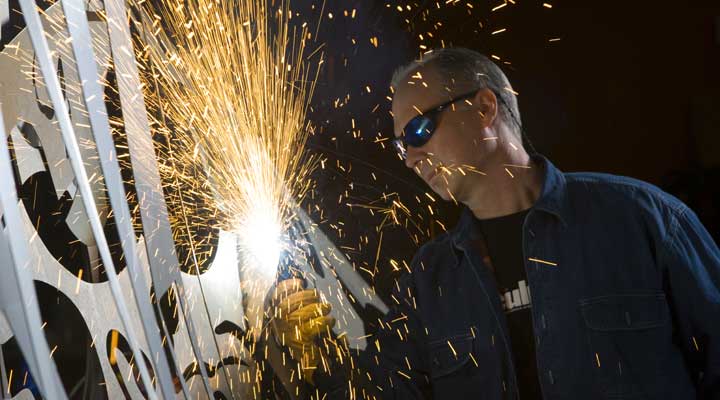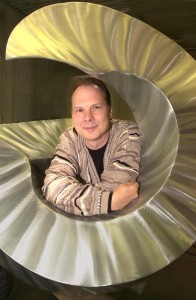Missouri Artist Profile
 photograph by Bob Linder
photograph by Bob Linder
Man of Steel
Although soft-spoken and not known to leap tall buildings in a single bound, sculptor Russ RuBert is by many measures a Man of Steel. Those who demand proof for such super-hero claims need only look at RuBert’s artwork, the multi-talented person behind the work, and his commitment to the hometown, vocational, and virtual communities in which he lives.

A graduate of Glendale High School in Springfield, where he was a math and science whiz, RuBert chose large-scale sculpture as a vocation because it blends his passion for art with his talent with computers and technology. As a sculptor his medium of choice is stainless steel, but he frequently uses othe metals and incorporates neon, plastic, glass, and other media. However, unlike most large-scale metal sculptors—who give detailed drawings to steelworkers to build the pieces for them—RuBert design and builds his own pieces in a 22,000-square-foot artist studio that includes a cutting-edge computer network with advanced imaging software that he developed; photography and modeling spaces; an array of welding and polishing equipment; laser cutters that slice huge sheets of plate steel with microscopic precision; girder hoists; a 60-foot Stinger crane, and much more. The building used to house a peanut butter factory.
Fusionism
Stainless steel represents one of the most recent mediums available to artists, so it is no surprise that RuBert’s work has a modern feel. However, when one thinks of steel, the images that come to mind are anvils, bridges, battleships, trains, and so on. But when critics review RuBert’s sculptural pieces they use terms like graceful, figurative, witty, and playful, RuBert coined the term “fusionism” to describe the creative process he uses to merge the multicultural imagery that defines his style with the large structural systems needed to mount indoor and outdoor, site-specific, sculptural works. Structurally, he achieves this fusion by incorporating complex balance points and hidden structural elements in his designs, and by computer-testing them for stability and structural integrity before production begins.
Community Catalyst
Russ RuBert and his wife Pam, also an artist, contribute much of their time, expertise, and resources to local and national organizations. As a board member of the Springfield Area Arts Council (SAAC), RuBert has helped raise more than $3 million in endowments for the 24 organizations in 19 communities that formed the Greater Ozarks Arts Initiative. ” He’s a great leader,” confided Twyla Boutwell, of the SAAC Staff. ” He sees things from many different sides.” (X-ray vision?) She also appreciates his down-to-earth style and recounted a day when RuBert abandoned his busy afternoon schedule to reconfigure and upgrade the SAAC computer system.
In November 2001 RuBert was elected to the board of directors of the International Sculpture Center (ISC), which reads like a “who’s who” of famous artists.
“I’m the token Midwesterner,” he chuckled. Among his contributions, RuBert developed the ISC’s Web Site Discussion Forum (at www.sculpture.org,) which enables a virtual community of artists worldwide to share information on production and technical aspects of contemporary sculpture. RuBert’s many contributions to his hometown arts community and the Springfield region have greatly enhanced the cultural attractions of the community and helped introduce the region to a worldwide audience of cultural tourists. Bullets seem an appropriate method to list RuBert’s recent contributions:
• RuBert joined the Springfield Area Arts Council board of directors in 1997. As current president of the board, he is helping revamp the cultural plan and spearheading efforts to turn an old creamery in Jordan Valley Park into an arts center.
• As president of the Springfield Sister Cities Association , he works to build better relations between Springfield and sister city Isesaki, Japan. In this effort he started the city’s Japanese Fall Festival, a popular tourist attraction, and instituted an international cultural exchange program that has generated more than 55 exchanges in 10 years, including a United Nations-sponsored art exhibition.
• RuBert is a founding member of the Springfield Program for Public Art, which sponsors several local arts programs.
• As president of the Friends of the Springfield Art Museum, RuBert started the Springfield Garden Tours and helped establish several scholarships and museum restoration projects.
• RuBert is president of RuBert Design International, his art and sculpture business, and RuBert Diversified Investments, a company that developed Springfield Industrial Park and works on other property redevelopment projects.
RuBert’s considerable talents first emerged nationally in 1991-97 when he collaborated with Georgia State University’s Language Research Center in Atlanta to create interactive art-and-technology environments for cognitive research with chimpanzees. The project, called Public Sphere, developed learning tools, games, and symbolic language systems for disabled children. The project was publicized in National Geographic, Time, and Newsweek, and televised on Nova and Discover.
For those who are just learning about the mild-mannered Russ RuBert, it may seem as though he has stepped straight out of a phone booth, like Clark Kent, or from a Marvel comic. But for those who know him through his art and community development work, they only know that it would take a real-life super-hero to replace him.
from the Artlogue — a publication of the Missouri Arts Council — Editor: Don Dyer
